

Law of the Rights of Mother Earth. Law of the Rights of Mother Earth (Spanish: Ley de Derechos de la Madre Tierra) is a Bolivian law (Law 071 of the Plurinational State), that was passed by Bolivia's Plurinational Legislative Assembly in December 2010.[1][2] This 10 article law is derived from the first part of a longer draft bill, drafted and released by the Pact of Unity by November 2010.[3] The full bill remains on the country's legislative agenda.
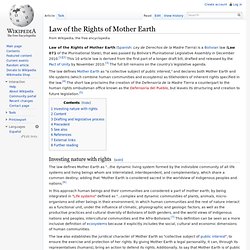
The law defines Mother Earth as "a collective subject of public interest," and declares both Mother Earth and life-systems (which combine human communities and ecosytems) as titleholders of inherent rights specified in the law.[4] The short law proclaims the creation of the Defensoría de la Madre Tierra a counterpart to the human rights ombudsman office known as the Defensoría del Pueblo, but leaves its structuring and creation to future legislation.[5] Investing nature with rights[edit] Content[edit] Drafting and legislative process[edit] Precedent[edit] See also[edit] Fight corporate personhood. Lecture 1: The Scope of International Environmental Law. United Nations Convention on the Law of the Sea. The United Nations Convention on the Law of the Sea (UNCLOS), also called the Law of the Sea Convention or the Law of the Sea treaty, is the international agreement that resulted from the third United Nations Conference on the Law of the Sea (UNCLOS III), which took place between 1973 and 1982.

The Law of the Sea Convention defines the rights and responsibilities of nations in their use of the world's oceans, establishing guidelines for businesses, the environment, and the management of marine natural resources. The Convention, concluded in 1982, replaced four 1958 treaties. UNCLOS came into force in 1994, a year after Guyana became the 60th nation to sign the treaty.[1] As of August 2013, 165 countries and the European Union have joined in the Convention.
However, it is uncertain as to what extent the Convention codifies customary international law. Historical background[edit] UNCLOS I[edit] UNCLOS II[edit] UNCLOS III[edit] Sea areas in international rights Internal waters Territorial waters. Overview - Convention & Related Agreements. The United Nations Convention on the Law of the Sea lays down a comprehensive regime of law and order in the world's oceans and seas establishing rules governing all uses of the oceans and their resources.
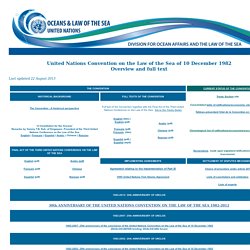
It enshrines the notion that all problems of ocean space are closely interrelated and need to be addressed as a whole. The Convention was opened for signature on 10 December 1982 in Montego Bay, Jamaica. Commission for Environmental Cooperation. The Commission for Environmental Cooperation (CEC) was established by Canada, Mexico, and the United States to implement the North American Agreement on Environmental Cooperation (NAAEC), the environmental side accord to the North American Free Trade Agreement.

The CEC supports cooperation among the NAFTA partners to address environmental issues of continental concern, including the environmental challenges and opportunities presented by continent-wide free trade. Origins and structure[edit] Commission for Environmental Cooperation. North American Agreement on Environmental Cooperation.
The North American Agreement on Environmental Cooperation (NAAEC) is an environmental agreement between the United States of America, Canada and Mexico as a side-treaty of the North American Free Trade Agreement.

The agreement came into effect January 1, 1994.[1] North American Free Trade Agreement. NAFTA GDP - 2012 : IMF - World Economic Outlook Databases (Oct 2013) The North American Free Trade Agreement (NAFTA; French: Accord de libre-échange nord-américain, ALÉNA; Spanish: Tratado de Libre Comercio de América del Norte, TLCAN) is an agreement signed by Canada, Mexico, and the United States, creating a trilateral rules-based trade bloc in North America.
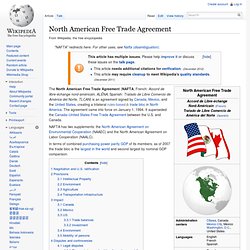
The agreement came into force on January 1, 1994. It superseded the Canada–United States Free Trade Agreement between the U.S. and Canada. NAFTA has two supplements: the North American Agreement on Environmental Cooperation (NAAEC) and the North American Agreement on Labor Cooperation (NAALC). U.S. Department of the Interior. United States Department of the Interior. The United States Department of the Interior (DOI) is the United States federal executive department of the U.S. government responsible for the management and conservation of most federal land and natural resources, and the administration of programs relating to American Indians, Alaska Natives, Native Hawaiians, territorial affairs, and insular areas of the United States.

The Department is administered by the United States Secretary of the Interior, who is a member of the Cabinet of the President. The current Secretary is Sally Jewell. There is not currently an appointed Inspector General. Mary Kendall is the acting Inspector General [3] The Department has often been humorously called "The Department of Everything Else" because of its broad range of responsibilities.[4] Bureau of Indian Affairs. The Bureau of Indian Affairs (BIA) is an agency of the federal government of the United States within the U.S.
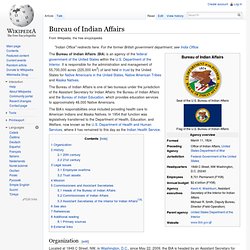
Department of the Interior. It is responsible for the administration and management of 55,700,000 acres (225,000 km2) of land held in trust by the United States for Native Americans in the United States, Native American Tribes and Alaska Natives. The Bureau of Indian Affairs is one of two bureaus under the jurisdiction of the Assistant Secretary for Indian Affairs: the Bureau of Indian Affairs and the Bureau of Indian Education, which provides education services to approximately 48,000 Native Americans. The BIA’s responsibilities once included providing health care to American Indians and Alaska Natives. In 1954 that function was legislatively transferred to the Department of Health, Education, and Welfare, now known as the U.S.
Organization[edit] Bureau of Land Management. The Bureau of Land Management (BLM) is an agency within the United States Department of the Interior that administers America's public lands, totaling approximately 247.3 million acres, or one-eighth of the landmass of the country.[1] The BLM also manages 700 million acres (2,800,000 km2) of subsurface mineral estate underlying federal, state, and private lands.
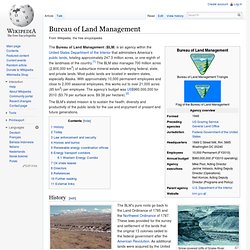
Most public lands are located in western states, especially Alaska. With approximately 10,000 permanent employees and close to 2,000 seasonal employees, this works out to over 21,000 acres (85 km2) per employee. The agency's budget was US$960,000,000 for 2010 ($3.79 per surface acre, $9.38 per hectare).[2] Bureau of Ocean Energy Management, Regulation and Enforcement. The Bureau of Ocean Energy Management, Regulation and Enforcement (BOEMRE), formerly known as the Minerals Management Service (MMS), was an agency of the United States Department of the Interior that managed the nation's natural gas, oil and other mineral resources on the outer continental shelf (OCS).[4][5][6][7][8] The Offshore program, which manages the mineral resources on the OCS, is divided into three regions: Alaska, Gulf of Mexico, and the Pacific Ocean.[8] Effective October 1, 2011, the duties of BOEMRE were split between the Bureau of Ocean Energy Management and the Bureau of Safety and Environmental Enforcement.[9] Headquartered in Washington, DC,[2] the Agency received most of its revenue from leasing federal lands and waters to oil and natural gas companies with a profit margin of 98%.

History[edit] The Minerals Management Service was created on January 19, 1982.[3] In January 1983, Congress passed the Federal Oil and Gas Royalty Management Act with the stated purpose:[11] S. United States Bureau of Reclamation. The United States Bureau of Reclamation (USBR), and formerly the United States Reclamation Service (not to be confused with the Office of Surface Mining Reclamation and Enforcement), is a federal agency under the U.S. Department of the Interior, which oversees water resource management, specifically as it applies to the oversight and operation of the diversion, delivery, and storage projects that it has built throughout the western United States for irrigation, water supply, and attendant hydroelectric power generation. Currently USBR is the largest wholesaler of water in the country, bringing water to more than 31 million people, and providing one in five Western farmers with irrigation water for 10 million acres of farmland, which produce 60% of the nation's vegetables and 25% of its fruits and nuts.
USBR is also the second largest producer of hydroelectric power in the western United States.[3] History[edit] Federal Executive Boards. The Federal Executive Boards (FEBs) were created in 1961 to foster communication, coordination and collaboration among Federal agencies outside of Washington, DC. They are under the jurisdiction of the Office of Personnel Management. Currently, approximately 88% of Federal employees are located outside the Washington, DC area. Across the nation, in 28 locations with a high concentration of Federal agencies and Federal employees, FEBs provide a forum for Federal leaders to connect to discuss management challenges and strategies.
The FEBs enable collaboration on agency missions and goals, common issues,and special initiatives. FEBs are also a resource for agencies to share best practices among their peers. History[edit] "The first 10 Federal Executive Boards (FEB) were established by Presidential Directive in 1961 to "increase the effectiveness and economy of Federal agencies.” Today, the Boards are more relevant than at any other time in history.
Functions[edit] Interior Museum. The Interior Museum is a museum operated by the United States Department of the Interior and housed at the Department's headquarters at the Main Interior Building in Washington, D.C., on the first floor. Opened in 1938, the museum's permanent exhibits are divided into galleries that focus on the work of the department's agencies, including the National Park Service, Bureau of Indian Affairs, Bureau of Land Management, Bureau of Reclamation, United States Fish and Wildlife Service and United States Geological Survey. A special feature are dioramas that display the work of these agencies, such as Coal Mine Explosion and Winter Use of the National Parks.
One diorama depicts an aerial view of the plan of central Washington, D.C. from 1939. Other exhibits include mineral and fossil specimens from federal lands. The museum's entrance area and other special display cases feature changing exhibits. Because of the museum's location, all visitors must present a photo ID to enter. References[edit] National Park Service. The National Park Service (NPS) is an agency of the United States federal government that manages all U.S. national parks, many American national monuments, and other conservation and historical properties with various title designations.[1] It was created on August 25, 1916, by Congress through the National Park Service Organic Act.[2] Office of Insular Affairs. The Office of Insular Affairs (OIA) is a unit of the United States Department of the Interior that oversees federal administration of several United States possessions.
It is the successor to the Bureau of Insular Affairs of the War Department, which administered certain territories from 1902 to 1939, and the Office of Territorial Affairs (formerly the Division of Territories and Island Possessions and then the Office of Territories) in the Interior Department, which was responsible for certain territories from the 1930s to the 1990s. The word "insular" comes from the Latin word insula ("island"). Office of Surface Mining. OSM Regional Structure Map OSM employee inspecting a mine. United States Fish and Wildlife Service. Arctic Refuge Law Enforcement Officer Heather Bartlett stands alongside her Super Cub, 2009 The United States Fish and Wildlife Service (FWS) is a federal government agency within the U.S. United States Geological Survey. IELRC.ORG - International Environmental Law Research Centre. Global commons.